#pannier dress
Explore tagged Tumblr posts
Text

Le Cachet de Paris, 1920
#Le Cachet de Paris#1920#1920s#Fashion history#Historical fashion#Historical clothing#Dress history#Vintage dress#Vintage fashion#Antique dress#Antique fashion#Antique clothing#Corset#Costuming#Costumes#Costume design#20th century#20th century art#20th century dress#20th century fashion#Turn of the century#pannier#panniers#pannier dress#robe de style#tulle#tulle dress#sheer dress#fashion#1920s dress
12 notes
·
View notes
Text
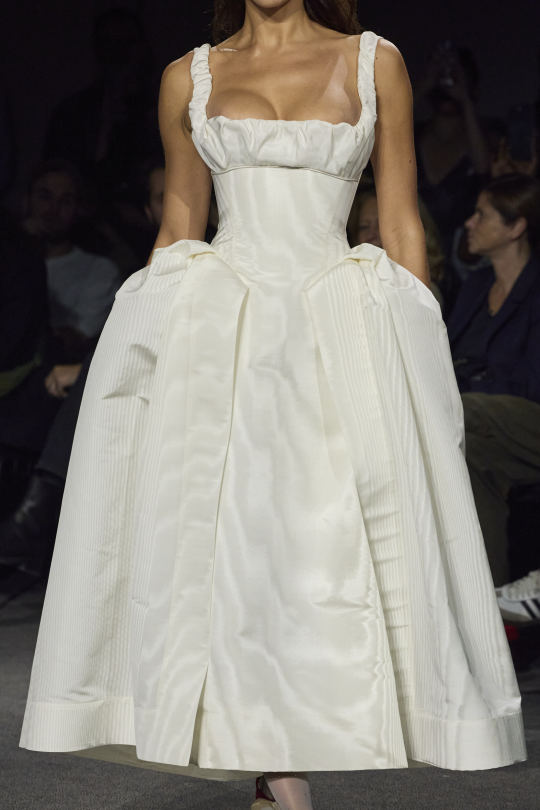
Andreas Kronthaler for Vivienne Westwood s/s 2024
#vivienne westwood#runway#model#ethereal#paris fashion week#pfw#fashion week#dollette#coquette#white dress#white aesthetic#all white#pale#pale aesthetic#pannier#cottagecore#cottage aesthetic#marie antoinette#versailles#detail#princess#princess aesthetic#princess dress#irina shayk#andreas kronthaler for vivienne westwood#andreas kronthaler#spring 2024#✨
1K notes
·
View notes
Text
grrrr why did people ever stop wearing mid-renaissance clothes
#yes I am mad bc I wanna go to fetes galantes with a friend in a few years#which will mean having to make a baroque gown and I just think Baroque dresses are so ugly 😭#give me back my beautiful renaissance shapes please!!! I am crying I am shaking etc#and by renaissance I do not mean whatever rigid monstrocities the british had going on during the tudor and elisabethan era#I mean my beautiful German/Dutch renaissance soft shapes#with just absolute madness in the sleeves and in the details#like at least rococo is a little fun bc panniers but baroque? I want to throw myself off a cliff.#'Early 16th century is when Central European fashion peaked and honestly we should've just kept that' remains the hill I will die on#like it's so fun and so stupid. you want a big silly hat? have a big silly hat! you want the poofiest sleeves to ever poof? go for it!#You want an ornamented fake bulge that is very dick shaped that has a little pocket in it for treats to give to the ladies#(top 10 flirting tips they don't tell you about! Works every time!!!)? Boy do I have the accessory for you!#but no we must have weird flowy shapes and then not even commit to that also lets all wear the worst hairstyle anyone has#ever conceived of. that's a good idea!#just completely lost literally what were people on about back then? A fucking disgrace I'm telling you!
11 notes
·
View notes
Text
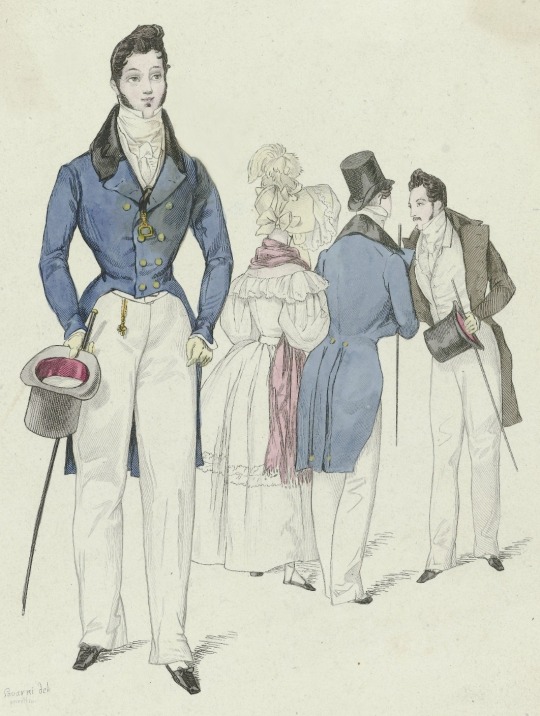
Toilette du soir in La Mode, 1830. Engraving after a drawing by Paul Gavarni (Rijksmuseum)
The constraints of dress inevitably follow those of the times: traditional “stiffness” for women regained its prior legitimacy with the Restoration and the July Monarchy (1830-1848). Restriction of liberty created an emphasis on rigidity: belts cinched over a corseted torso; dresses whose panniers recovered their former breadth; balloon sleeves to better balance the two volumes cut at the waist; jupe en cloche (bell-shaped skirt); “wasp” waist. Lastly, the shoulders, more emphasized, loomed over hips drowning in folds. Gathers and folds once more masked forms that the Revolution had made more visible. Social mores rediscovered their tradition and movement its restriction. Once again, the garment “artificialized” the anatomy: the upper body became fixed while the lower body was hidden beneath gathers, linings, hoops, and hems.
— Georges Vigarello, “The Nineteenth Century: From Artifice to Anonymity,” in Fashioning the Body edited by Denis Bruna.
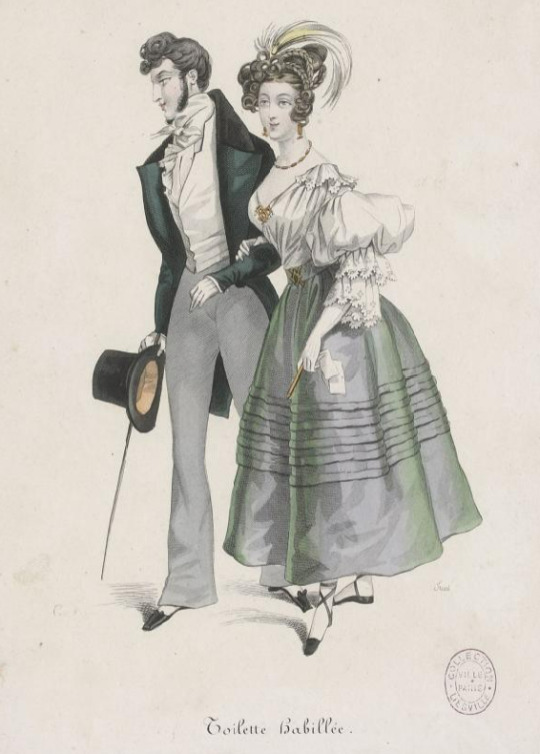
Toilette habillée in La Mode, 1830. Engraving by Truebe after a drawing by Gavarni (Paris Musées).
#Eighteen-Thirties Thursday#1830s#fashion history#paul gavarni#romantic era#fashion#dress history#fashion plate#la mode#fashioning the body#is 'panniers' the right word?#the book also doesn't say who translated it into english#p.s. everytime a gavarni picture looks awkward it's actually the engraver's fault#gavarni did nothing wrong ever
120 notes
·
View notes
Photo
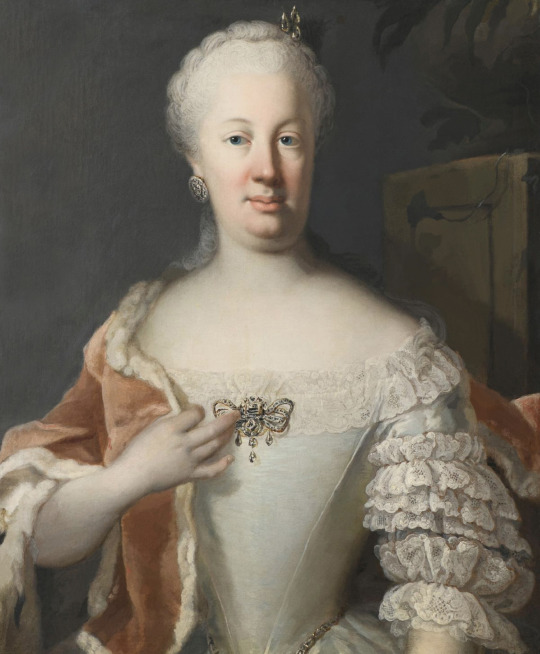


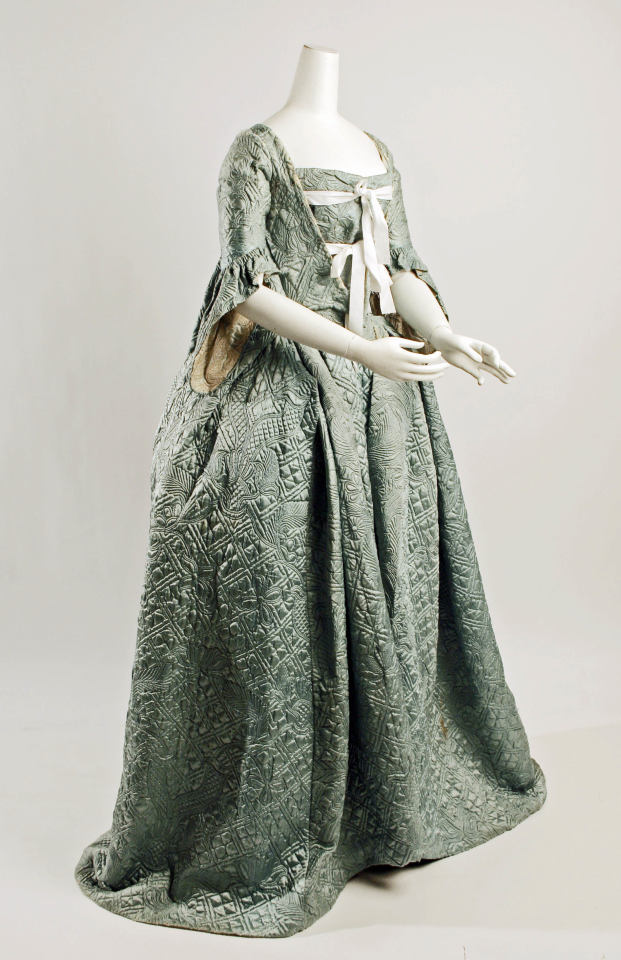

1750s dresses -
Top row Lady by ? (Auktionhaus Wendl - 25Jun22 auction Lot 2803); removed spots and fold line w Pshop 2918X3532 @150 1.7Mj.
Second row 1750s British stomacher (Metropolitan). From their Web site 2919X4000.
Third row 1750s Mademoiselle de Coislin by Louis Tocqué (National Gallery - London UK). From tumblr.com/historical-fashion-devotee 1280X1599.
Fourth row left ca. 1750 Front of robe à la française (location ?). From tumblr.com/sims4rococo76 1893X2927.
Fourth row right ca. 1750 Back of robe à la française (location ?). From tumblr.com/sims4rococo76 2048X3056.
#1750s fashion#LouisXV fashion#Rococo fashion#Georgian fashion#curly hair#short hair#scoop neckline#lace bertha#ruffled sleeves#stomacher#Mademoiselle de Coislin#Louis Tocqué#chemis#square neckline#floral dress ornaments#wrap#robe à la française#sacque back#panniers
13 notes
·
View notes
Text
youtube
#Georgian#historical fashion#georgian#historical clothing#sultana#sack back dress#panniers#petticoat#stomacher#1740s#1760s#Dido Elizabeth Belle#stays#1780s#italian gown#Georgiana Cavendish#1700s#video#youtube video#Youtube
7 notes
·
View notes
Text

Todays fit !
#outfit#jfashion#fancy#fairykei#mikiosakabe#angelic pretty#I’m wearing a 6% pannier under the dress so there’s actually a rainbow gradient which didn’t capture well
3 notes
·
View notes
Text
Drawings I’ve done over the past whatever that I’m cool with showing, even if they aren’t exactly how I’d hoped they turn out. Each one had something I was happy with though. Always practicing.
Some of these are covers of manga because I was sorting through them and thought it’d be fun to draw some of them.








4 notes
·
View notes
Text
That's the prettiest robe a la francaise I've ever seen.
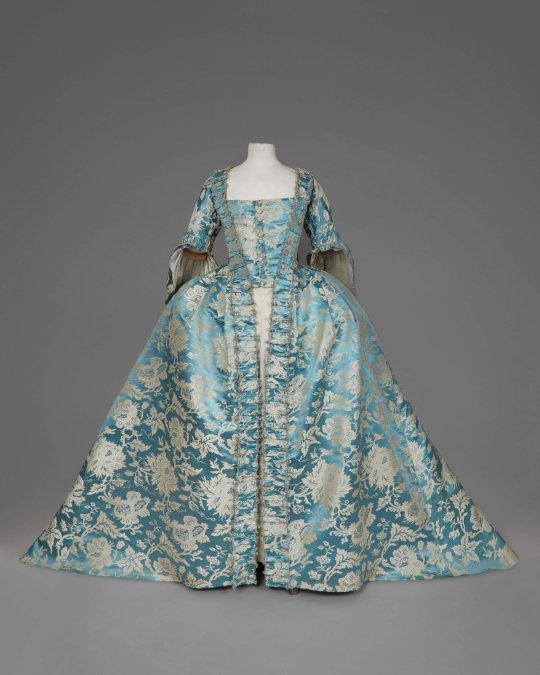

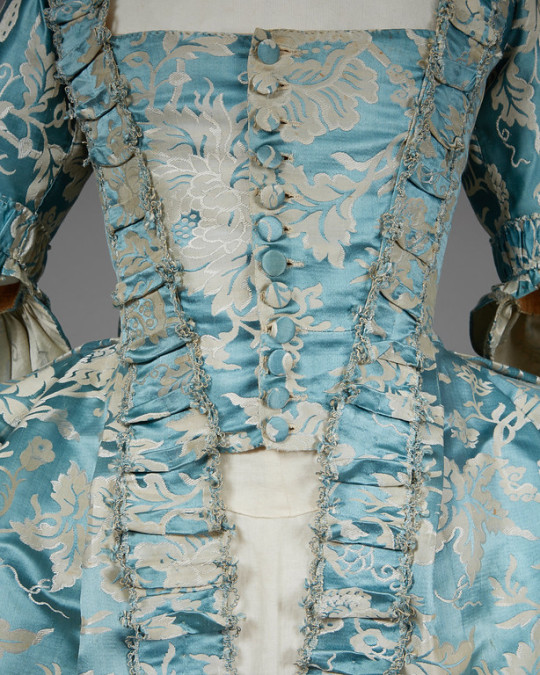

Teal Silk Brocade Mid-eighteenth Century Robe a la Francaise (Robe du Cour). Whitaker Auction Fall 2016.
#fashion#dress#robe a la francaise#ballgown#ball gown#hoopskirt#hoop skirt#pannier#18th century#1700s#rococo
947 notes
·
View notes
Text
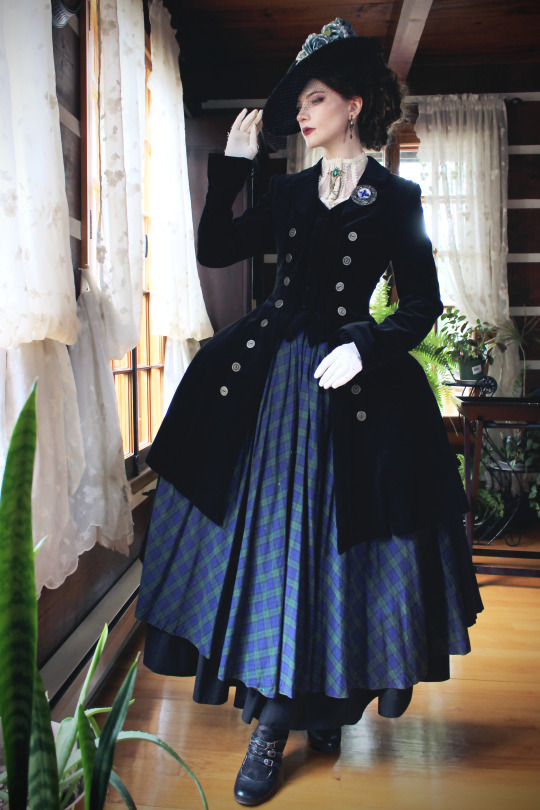

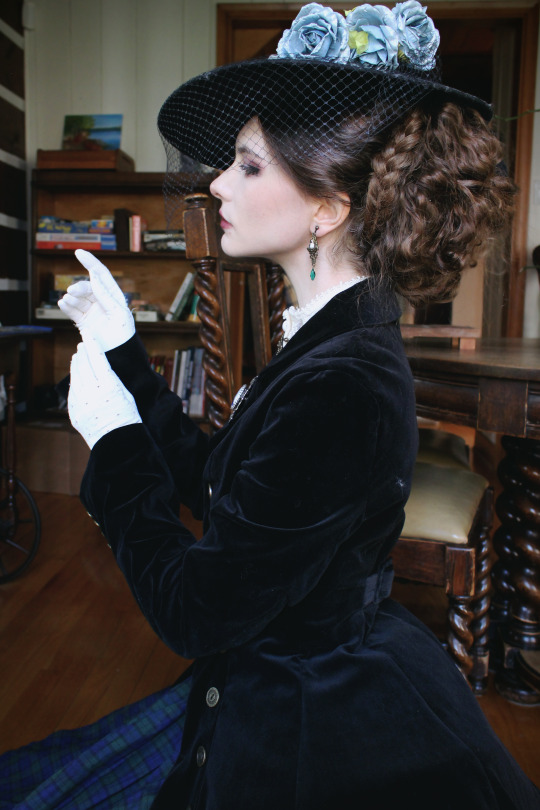
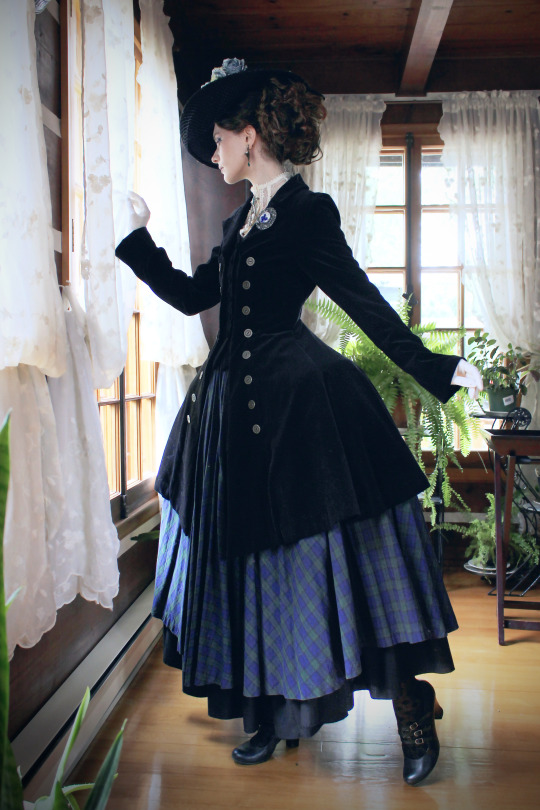
The tartan duchess
Outfit rundown Jacket: second-hand Atelier Boz Dress: second-hand Juliette et Justine Underskirt/petticoat: second-hand Black Peace Now Shoes: old Hush Puppies Hat: vintage with added blue flowers High collar: second-hand Abilletage Brooches: vintage Gloves: vintage Earrings: Phantom Jewelry Rococo panniers: a gift from the designer of @british_wardrobe
#fashion#ega#egl#historybounding#historical fashion#historical hair#rococo fashion#18th century fashion#vintage#vintage fashion#vintage style#juliette et justine#atelier boz#goth#goth fashion#gothic fashion#gothic style#alternative fashion#second-hand fashion#fanny rosie#fannyrosie
2K notes
·
View notes
Text

Andreas Kronthaler for Vivienne Westwood s/s 2024
#vivienne westwood#model#marie antoinette#ethereal#paris fashion week#pfw#fashion week#dollete aesthetic#coquette#white aesthetic#dollette#pannier#all white#pale aesthetic#pale#silk#white dress#18th century#1700s#1700s fashion#versailles#corset#detail#behind the scenes#backstage#fashion photography#andreas kronthaler for vivienne westwood#andreas kronthaler#spring 2024#coco corré
38 notes
·
View notes
Photo

I tried to answer this succinctly, but it turned into an essay. (Sorry.)
The Princess and the Frog was not accurate, strictly speaking, but dinging it for that would be like criticizing the Lion King for not being a realistic wildlife documentary. Accuracy wasn't really the point. Given the fantastical elements and fictional nations like “Maldonia”, I suppose we're meant to understand this as a bit removed from the real New Orleans. It's more a a jazz-flavored fairy tale than a historical fiction.
But for discussion's sake....
Is it fashion-accurate to its 1926 timeframe? Ehhh, sort of. It pays homage to 20s fashion trends with cloche hats, furs and feathery headpieces, but without fully committing to it. The waistline on almost all of Tiana's clothing is too high for the 20s, and the the shapes of her fancier costumes take a lot of liberties, or deviate wildly from the style of the period.
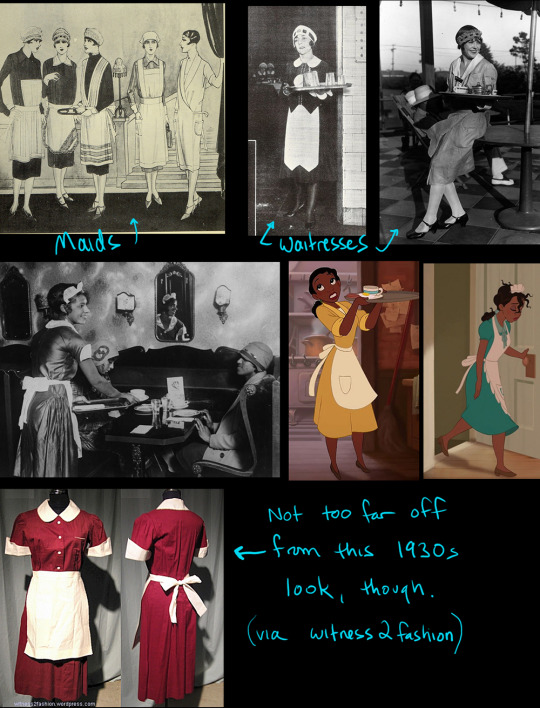
In the 20s, dresses (including workaday stuff) tended to have a straight up-and-down shape to it - kind of a low-waisted rectangle that de-emphasized curves instead of highlighting them. There are valid reasons to play fast and loose with that, though (something I’m definitely guilty of as well). One of those reasons is communication.
For instance, speculatively, the filmmakers wrote Tiana as a hard-working waitress and wanted her to look the part, so they made the choice to clothe her in something familiar - that gingham dress of mid-century shape that we broadly associate with diner waitresses. Actual waitress uniforms of the 20s had a fair bit of overlap with maid uniforms at the time too, and I can see why they wouldn't want to risk the confusion. It's more important to communicate clearly with the larger audience than to appease a small faction of fashion nerds who'd notice or care about the precision.
I don't think it's a case of the designers failing to do their research - I'm sure they had piles of references, and maybe even consultants - but they also had to have priorities.
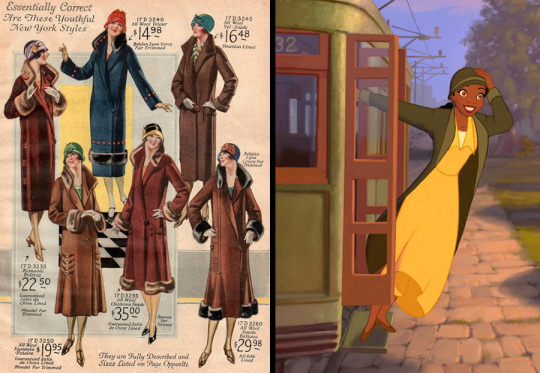
With her hat and coat on, she looks a lot more 1920s-shaped.
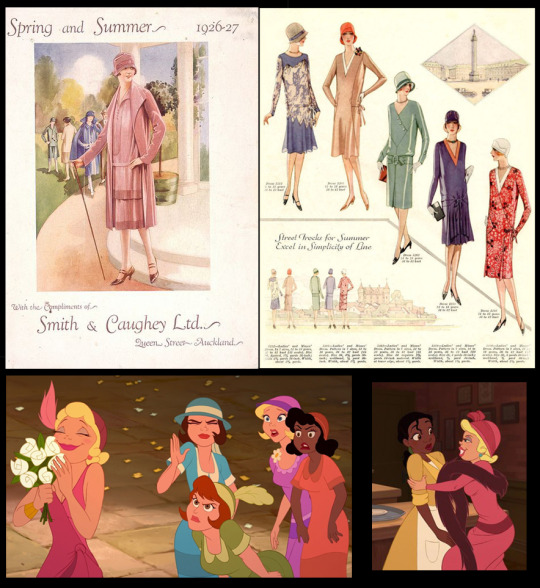
Pretty consistently, the indication of the characteristic 1920s drop waist is there, but the approach otherwise ignores the 20s silhouette. The clothes hug the body too much. This may be about appealing to a 2000s audience, visually speaking, but also could be an animation thing. Maybe both. For practical reasons, clothes in 2d animation are usually more a sort of second skin than something that wears or behaves like realistic fabric.
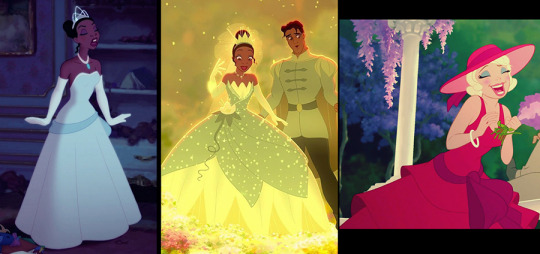
These are not in the 1920s ballpark at all. Tiana's blue gown looks like your basic Disney brand invention. Strapless things would have been extremely unusual and the overall shape is far out of step. Excusable, I guess, because it's a costume in context. Charlotte looks like she’s heading for a mimosa brunch in a modern maxi dress.
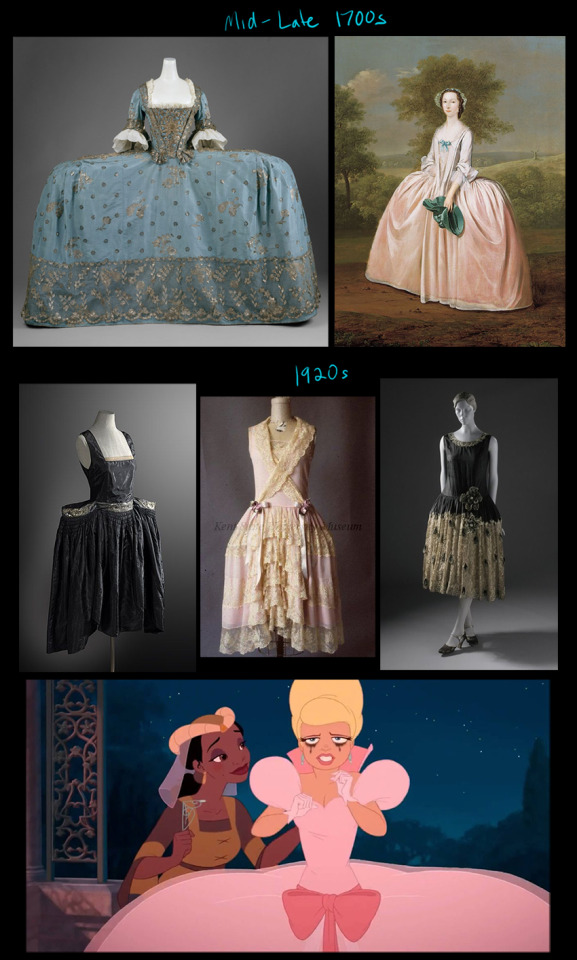
Charlotte's princess dress did seem to be calling back to the ultra-wide pannier side hoops of the 18th century - something that made a reappearance for part of the 20s, albeit in much milder form called robe de style. I'm not sure if the filmmakers were alluding to that at all, really, but either way, her dress is hilarious.
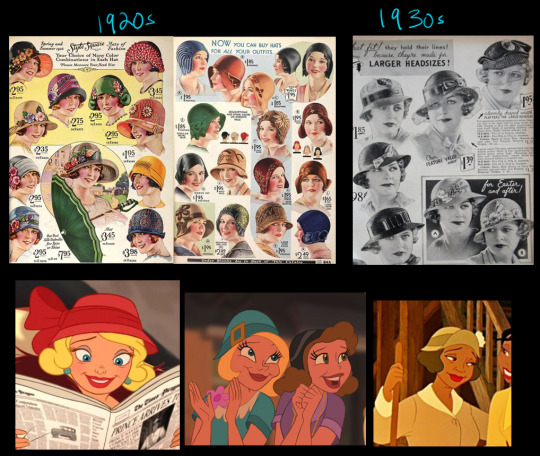
They only went about halfway with the cloche hats. The 1920s cloche really encapsulated the cranium, almost entirely covered bobbed hair, and obscured much of the face from certain angles, so it's easy to see why they've been somewhat reined in for the film. Still, it ends up looking more 1930s, where the hats started to recede away from the face, evolving in the direction of the pillbox.
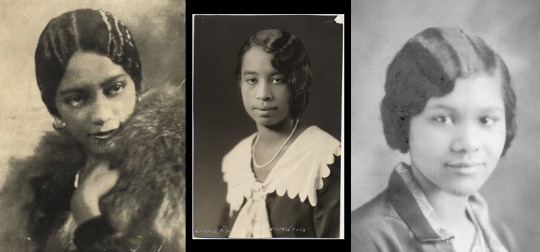
Similarly, Tiana's hair is not very reminiscent of the bobbed, close-to-the-cranium style of the period, but I think that could legitimately be written off as characterization. She's not at all the type of person who'd fuss about going à la mode. Not everyone bobbed and finger-waved their hair.
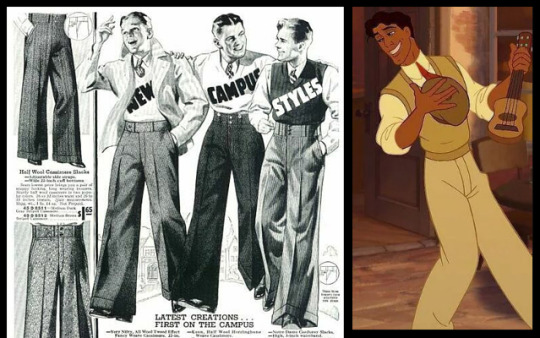
The clothes Prince Naveen is introduced in are very 1920s collegiate in spirit - the wide-leg oxford bags, the sleeveless pullover sweater, the flat cap, and high, stiff collar. The ukulele and banjolele were pretty trendy instruments at the time too.
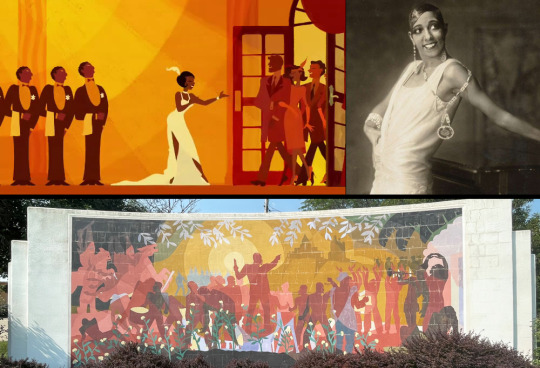
Definitely some Josephine Baker vibes here. Also, the look of this whole fantasy sequence was reportedly inspired by the works of Aaron Douglas, a luminary painter of the Harlem Renaissance known for his depictions of the lives of African-Americans. (The mural is in Topeka, Kansas.)
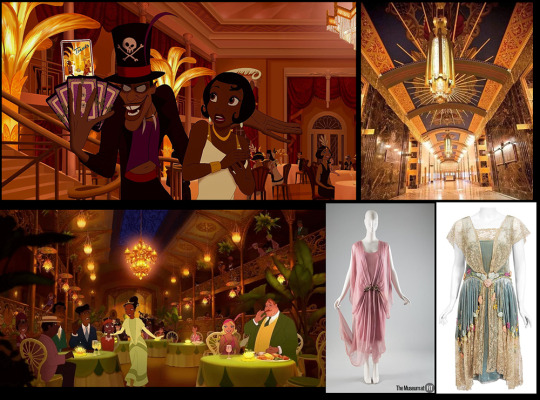
They pretty much nailed the Art Deco. It's gorgeous. Looks somewhat inspired by the interiors of some of the Ralph Walker-designed NYC architecture, plus some French Quarter balcony flair for the final manifestation of Tiana's Place. Her dress here does resemble some gauzy mid-1920s looks, too.
------------------------------------------------
Culturally speaking...
New Orleans is an unusual place. Because some of the colonial Spanish and French laws and conventions that New Orleans evolved under persisted even after its inception into the United States; because it was such a heterogeneous hub of indigenous and immigrant peoples; and because it had a considerable population of free people of color (mostly Creole), it did not function quite like the rest of the South leading up to the Civil War, nor for a while after. Its particular coalescence of cultures made it its own unique sort of culture within the country, within the region, within the state of Louisiana even. By the early 20th century, though, regardless of the not-very-binary nature of New Orleans, Jim Crow laws were enforcing a literal black-and-white distinction, and not an evenhanded one, by far. In that aspect, the city had begun to resemble the rest of the South.
The film nods at the wealth disparity, but goes on to paint a pretty rosy picture of race and class relations at the time. Still it's not unbelievable that some people were exceptions to the rules. You could probably find a few compartments of old New Orleans society that resisted segregation or certain prejudicial norms, preferring to do things their own way. That aside, the film wasn't trying to confront these topics. Not every piece of media should have to. Sometimes breaking away from miserable period piece stereotypes is refreshing. I'm not sure it could have handled that meaningfully given the running time, narrow story focus, and intended audience, anyhow. (But you could perhaps also make a case that family films habitually underestimate younger audiences in this way.)
------------------------------------------------
Raymond the firefly I guess is the film's Cajun representation. There's not much to say about it, except perhaps to note that Evangeline is a reference to the heroine of a Longfellow poem of the same name. The poem is an epic romance set during the expulsion of the Acadians from the eastern provinces of Canada and the northernmost reaches of the American colonies (now Maine) by the British in the mid-1700s. Many exiled Acadians gradually migrated south to francophone-friendly Louisiana, settling into the prairies and bayous, where 'Acadian' truncated into the pronunciation 'Cajun'. Evangeline - who is only finally reunited with her love when he’s on his deathbed - has become an emblem of the heartbreak, separation and faithful hope of that cultural history, and there are parishes, statues and other landmarks named after the her throughout Louisiana.
------------------------------------------------
Voodoo does have a very historical presence in New Orleans, having arrived both directly from West Africa and by way of the Haitian diaspora (where it would more properly be called Vodou). While I don't think Disney's treatment of it was especially sensitive or serious, it also wasn't the grotesquely off-base sort of thing that media of the past has been known to do. It was largely whittled down to a magical plot component, but it wasn't so fully repurposed that it didn't resemble Voodoo at all either - and that's mostly owing to the characters, because it does appear the writers pulled from history there.
It’s apparently widely held that Dr. Facilier is a Baron Samedi caricature - and likely that's true, in part - but I have the impression he's also influenced by Doctor John. Not the 20th century funk musician, but the antebellum “Voodoo King” of New Orleans. Doctor John (also called Bayou John, Jean La Ficelle, and other aliases) claimed to be a Senegalese prince. He became well known as a potion man and romance-focused prognosticator to people from all corners of society. Though highly celebrated and financially successful at his peak, he seems ultimately remembered as an exploitative villain.
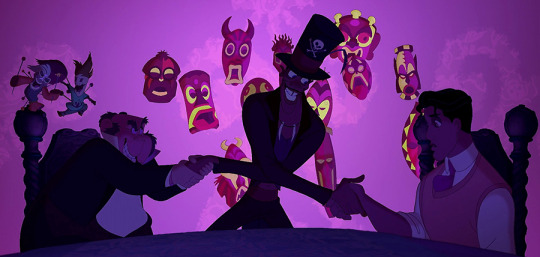
To my recollection, the film sort of gingerly avoids referring to Facilier as a Voodoo practitioner directly (I think he's more generically called a witch doctor in the script?) but it does seem to imply his 'friends on the other side' are a consortium of loa. It's mostly abbreviated into nebulously evil-seeming special FX, glazing over any specificity or dimensionality, but it does also loop back around as a vehicle of moral justice. Loa are all very individualistic and multi-faceted, but they do have reciprocal rules for asking favors of them.
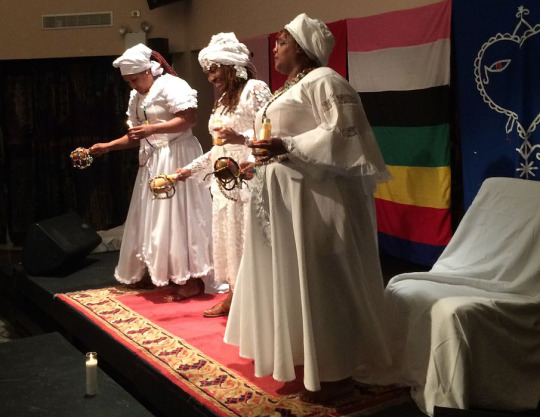
There's also the benevolent counterpart in Mama Odie's character. Her wearing ritual whites has a definite basis in Voodoo/Vodou practice, and her depiction as a fairy godmother-like figure isn't entirely out of step with how a mambo may have been perceived...in a very general sense. They were/are ceremonial leaders and community bastions who people would seek out for help, advice and spiritual guidance. More than just emanating matronly good vibes, though, some have wielded considerable political and economic power.
(Just my opinions here. I've done a lot of reading on the subject for research but I'm no authority with any special insider understanding of Voodoo, and I really shouldn't be relied upon as an arbiter of who has or hasn't done it justice in fiction.)
------------------------------------------------
In summary--
Culturally, I think the film is respectably informed but paints a superficially genteel picture. The set pieces are gorgeous, but the story mostly delivers a sort of veneer of New Orleanishness. And as for fashion, well, it’s the 1920s run through a Disney filter. It’s very pretty, but it’s only as proximally accurate as seemed practical.
I don’t know that any of that really matters so much as whether or not it achieved what it intended, though. As a charming yarn and as a tribute to New Orleans and the Jazz age, I think it’s mostly successful. It’s also really beautifully animated!
#princess and the frog#disney#1920s#new orleans#jazz#fashion#voodoo#vodou#history#animation#art deco
5K notes
·
View notes
Photo
We kinda started devolving earlier than that, but I wish we wore these giant dresses more often again.

18th century ball gown
#fashion#dress#robe a la francaise#robe a l'anglaise#ballgown#ball gown#hoopskirt#hoop skirt#pannier#crinoline#18th century#1700s#rococo
382 notes
·
View notes
Text




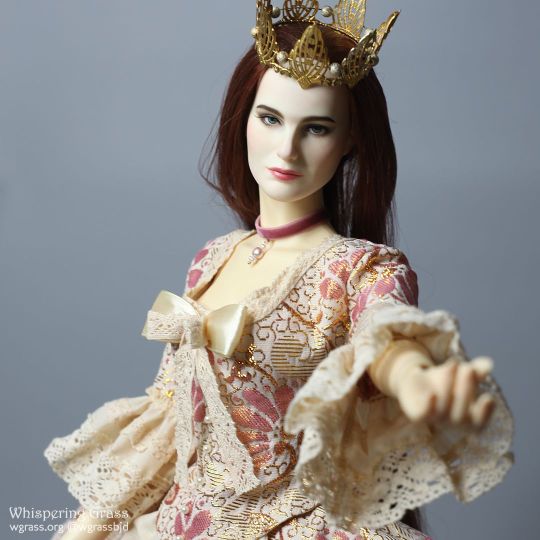




Grand Court Rococo dress in pink and cream colors. Made after late XVIII Rococo fashion, right before French Revolution. Striking dresses featured by Marie Antoinette had a quirky super wide but flat skirt and were made out of fine silks or rich brocades. No way such dresses could hold the shape without strong wire support. So I created a basket / pannier wire armature which holds the skirt in place.
#bjd#commission#etsy#crafts#art#ball-jointed doll#bjd makeup#iplehouse#dollshe#bjd clothes#rococo#rococo fashion#period fashion#xviii fashion
165 notes
·
View notes
Text


Robe à la Française
1760-1770
The Metropolitan Museum of Art
"Women with coquettish airs were imposing in robes à la française and robes à l'anglaise throughout the period between 1720 and 1780. The robe à la française was derived from the loose negligee sacque dress of the earlier part of the century, which was pleated from the shoulders at the front at the back. The silhouette, composed of a funnel-shaped bust feeding into wide rectangular skirts, was inspired by Spanish designs of the previous century and allowed for expansive amounts of textiles with delicate Rococo curvilinear decoration. The wide skirts, which were often open at the front to expose a highly decorated underskirt, were supported by panniers created from padding and hoops of different materials such as cane, baleen or metal. The robes à la française are renowned for the beauty of their textiles, the cut of the back employing box pleats and skirt decorations, known as robings, which showed endless imagination and variety."
This is one of the dresses that I was truly surprised to see had never been on display, because to me this dress epitomizes the rococo era with its pastel blue, delicate floral pattern, pretty ruffles and ribbons, and flirtatious bows. Imagine how stunning it must have been with all of its lacy sleeve ruffles and undergarments, carefully rouged cheeks, glittering jewelry, and huge elaborate hair. It is truly one of my favorites.
315 notes
·
View notes
Photo
[ID: a pale Western-style dress from 1824. It has a ruched bodice trimmed in a v-shape, a fairly close-fitting and slightly raised waist that connects to the skirt with few or no gathers. The skirt flares slightly and ends in subtle rows of ruffles at the base. The dress has long sleeves that puff around the shoulders and slowly narrow before growing fitted at the wrists, and end with pointed cuff details. End ID]

Dress, 1824.
#fashion#history#ooh this is fascinating#maybe it's the color#but it looks like a style in transition#it helps me better connect the dots between the high-waisted greco-roman inspired regency stuff#with later increasingly structured garments#so i can imagine the skirt expanding and the sleeves puffing more#you've got the still-higher waist but it's not right under the bust anymore#definitely got the ornamentation you'd see on earlier stuff but the shape of the trim on the bodice suggests later garment shapes#with more fitted bodices#so if i were to draw a line between the regency period through to the 1860s or so#this helps bridge the gap between the extremes#it's definitely earlier#but as someone who's only looked at this stuff as an amateur and not a historian#this helps me connect the pieces#also this is interesting to me because it helps me understand how bodice fitting looks different in the 18th vs 19th centuries#(speaking of broad silhouette trends)#because dramatic waist with wide skirts was a thing on either end of the regency period#but an 1850s dress for example is very different from anything involving. say. a stomacher (or panniers!)#the trend away from angular and towards curves while still maintaining the same kind of optical illusion#here you see the v shape but the trim gives it a much much softer appearance than i see on 18th century gowns
58 notes
·
View notes